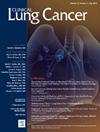Kirsten Rat Sarcoma Virus Mutations Effect On Tumor Doubling Time And Prognosis Of Solid Dominant Stage I Lung Adenocarcinoma
IF 3.3
3区 医学
Q2 ONCOLOGY
引用次数: 0
Abstract
Introduction
To analyze the impact of Kirsten-Rat-Sarcoma Virus (KRAS) mutations on tumor-growth as estimated by tumor-doubling-time (TDT) among solid-dominant clinical-stage I lung adenocarcinoma. Moreover, to evaluate the prognostic role of KRAS mutations, TDT and their combination in completely-resected pathologic-stage I adenocarcinomas.
Methods
In this single-center retrospective analysis, completely resected clinical-stage I adenocarcinomas presenting as solid-dominant nodules (consolidation-to-tumor ratio > 0.5) in at least 2 preoperative computed-tomography scans were enrolled. Nodules’ growth was scored as fast (TDT < 400 days) or slow (TDT > 400 days). KRAS-mutated adenocarcinomas were identified with next-generation sequencing. Logistic- and Cox-regressions were used to identify predictors of fast-growth and disease-free survival (DFS), respectively.
Results
Among 151 patients, 83 (55%) had fast-growing nodules and 64 (42.4%) were KRAS-mutated.
Fast-growing nodules outnumbered in the KRAS-mutated group (n = 45; 70.3%), median TDT 95-days (interquartile range, IQR 43.5-151.5) compared to the KRAS wild-type group (38, 43.7%), median TDT 138-days (IQR 70.3-278.5). KRAS-mutations predicted faster-growth at multivariable analysis (P = .009).
In a subgroup analysis including 108 pathologic-stage I adenocarcinomas, neither KRAS-mutations (P = .081) nor fast-growing pattern (P = .146) affected DFS. Nevertheless, the association of KRAS-mutations and fast-growing pattern identified a subgroup of patients with worse DFS (P = .02). The combination of fast-growing and KRAS-mutations (hazard-ratio 2.97 [95%CI 1.22-7.25]; P = .017) and average nodule diameter at diagnosis (hazard-ratio 1.08 [95%CI 1.03-1.14]; P = .004) were independent predictors of worse DFS.
Conclusion
KRAS mutations are associated to faster growth, in clinical-stage I adenocarcinoma presenting at diagnosis as solid-dominant nodules undergoing complete resection. Moreover, faster-growth identifies a subgroup of pathologic-stage I KRAS-mutated adenocarcinomas with higher recurrences.

Kirsten大鼠肉瘤病毒突变对实体显性I期肺腺癌肿瘤加倍时间和预后的影响。
目的:分析kirsten大鼠肉瘤病毒(KRAS)突变对固体显性临床I期肺腺癌肿瘤倍增时间(TDT)估计肿瘤生长的影响。此外,为了评估KRAS突变,TDT及其联合在完全切除的病理期I腺癌中的预后作用。方法:在这项单中心回顾性分析中,入选了至少2次术前计算机断层扫描中完全切除的临床I期腺癌,表现为实性优势结节(实变与肿瘤比>.5)。结节生长分为快(TDT < 400 d)和慢(TDT < 400 d)。kras突变腺癌通过下一代测序鉴定。分别使用Logistic回归和cox回归来确定快速生长和无病生存(DFS)的预测因子。结果:151例患者中,83例(55%)为快速生长结节,64例(42.4%)为kras突变。kras突变组快速生长的结节数量多于对照组(n = 45;与KRAS野生型组(38.43.7%)相比,中位TDT为95天(四分位数间距,IQR 43.5-151.5),中位TDT为138天(IQR 70.3-278.5)。在多变量分析中,kras突变预示着更快的生长(P = 0.009)。在包括108例病理期I腺癌的亚组分析中,kras突变(P = 0.081)和快速生长模式(P = 0.146)均未影响DFS。然而,kras突变和快速生长模式的关联确定了一组DFS较差的患者(P = 0.02)。速生与kras突变组合(风险比2.97 [95%CI 1.22 ~ 7.25];P = 0.017)和诊断时平均结节直径(危险比1.08 [95%CI 1.03-1.14];P = 0.004)是较差的生存状态的独立预测因子。结论:在临床I期腺癌中,KRAS突变与更快的生长有关,在诊断时表现为固体显性结节,需要完全切除。此外,更快的生长确定了一个复发率更高的病理I期kras突变腺癌亚组。
本文章由计算机程序翻译,如有差异,请以英文原文为准。
求助全文
约1分钟内获得全文
求助全文
来源期刊

Clinical lung cancer
医学-肿瘤学
CiteScore
7.00
自引率
2.80%
发文量
159
审稿时长
24 days
期刊介绍:
Clinical Lung Cancer is a peer-reviewed bimonthly journal that publishes original articles describing various aspects of clinical and translational research of lung cancer. Clinical Lung Cancer is devoted to articles on detection, diagnosis, prevention, and treatment of lung cancer. The main emphasis is on recent scientific developments in all areas related to lung cancer. Specific areas of interest include clinical research and mechanistic approaches; drug sensitivity and resistance; gene and antisense therapy; pathology, markers, and prognostic indicators; chemoprevention strategies; multimodality therapy; and integration of various approaches.
 求助内容:
求助内容: 应助结果提醒方式:
应助结果提醒方式:


